Roof ventilation from a profiled sheet: recommendations for design and installation
If your house is just being built, then it's time to think about a quality roof. Perhaps you plan to choose a hard coating like profiled sheets? In order for the ventilation of the roof from the profiled sheet to be properly organized, you should adhere to the recommendations and not make mistakes. Remaking anything will be technically problematic.
Roofing can deteriorate or even collapse from external factors. It would be nice to think out protection against uncomfortable temperatures, moisture accumulation, its penetration, as well as other unpleasant things that threaten your roof. If you do not make the right conclusions about air exchange on the roof, then in the worst case, the bearing system in the attic will suffer. In general, there is nothing complicated.
In our article you can familiarize yourself with the device of a roofing pie for coating from a profiled sheet. You will receive tips from which to make a set of optimal solutions.
The content of the article:
Roof ventilation from profiled sheet
The roof ventilation device is a capacious stage of roofing, along with insulation and waterproofing. The roof will not be threatened with destruction only under normal conditions in the attic and on the roof itself.
Homes need ventilation outlets that are made on the roof. The condition of the roof depends on local ventilation. The growing demand for housing with an attic has led to the fact that local air exchange under the roof and in it is organized more carefully.

Profiled sheet (corrugated board, corrugated sheet) is a facing material for roofs and walls, made of galvanized steel by cold rolling. Sheet blanks in the process are made wavy: with square, trapezoidal and other shapes. The material eventually becomes stronger.
Roofing from corrugated board should be protected from:
- moisture
- icing;
- elevated temperatures.
Ice is formed due to heated air in the roof. The lower layers melt, but quickly harden if there is frost on the street. For corrugated board, ice outside is not a problem, but ice will gradually fill the gutters.
Icing is also formed inside - from condensate. Warm air escapes through the cake, enters the cold stream of the ventilation gap of the roof and turns into moisture. In summer, the professional sheet protects well from rains, but overheats if there is poor ventilation under it.
Correct air exchange in the roof from corrugated board
Roof ventilation is simple. Air enters from the eaves overhangs and rises to the top - the ridge (ridge). Leaves through cracks near the crest or special removers.
The air gap is made due to the lathing: it separates the profiled sheet and waterproofing (waterproofing). Between the hydroprotection and the transverse battens, the battens leave gaps - due to vertically oriented battens - counterracks.
These spaces become channels of natural ventilation. Between the insulation and waterproofing also make a gap, but not always. In the ridge, moisture protection is equipped only by means of a seal, waterproofing is not laid there.
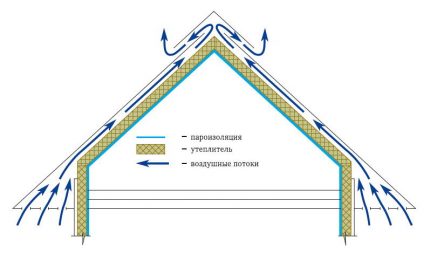
Sometimes the crate is made solid, and not thinned, that is, without crossed laths. Then take moisture-resistant plywood boards with a thickness of about 1 cm, lay on the rafters, but with the addition of transverse slats between them. These slats pick up to 10 cm in height, if you put them on the edge. It turns out additional protection against moisture.
If we talk only about the insulating layers, then keep in mind that the waterproofing is the highest, the insulation is below the insulation, and under it is the vapor barrier.
A complete diagram of a standard roofing roof cake made from corrugated board:
- At the bottom there is a solid binder.
- Above is the base of the roof - the rafters. Between her rafters lay insulation sections. Below them is a thin vapor barrier layer. Set the vapor barrier before laying the thermal insulation and before connecting the hem with the rafter.
- Even higher is the first air gap or waterproofing immediately.
- Next comes the crate and the main ventilation gap.
- Decking is located above this air gap.
Lay waterproofing sheets perpendicularly to a slope. Make several adjacent strips with an overlap of 10-15 cm and process it with duct tape.
Move from the overhangs to the ridge. Lay waterproofing sheets with small drooping waves between the slats. Allocate 1-2 cm vertically for each.
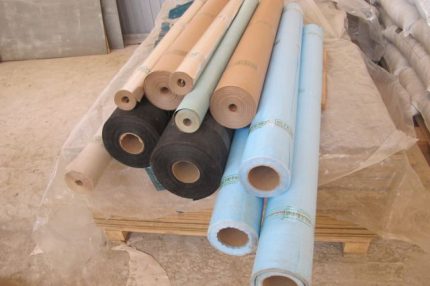
Sometimes waterproofing is organized in two layers: under a row of counter rails and above it or on top of the entire crate. Ventilation will not get worse, and moisture will less threaten the roof and the attic. Then waterproofing is put on the insulation.
Canopies and roof sections above terraces / verandas do not need organized air exchange. For a roof with a very steep slope, minimal ventilation is enough, and for large areas from corrugated board, ventilation outlets - aerators are needed.
When the professional sheets are laid, free space is left in place of the ridge. So lay natural ventilation. This method also reduces the temperature, because on hot days the metal heats up quickly.
Decking has grooves, which in combination with ventilated ridges makes air exchange at the top of the roof more efficient. The grooves leave gaps between the sheet and the ridge, and even below the overhangs. The holes at the wave level should be repaired, and below it should be covered with a net so that less snow falls.It will be worse if the gaps fill the leaves and dirt: air exchange can then stop.
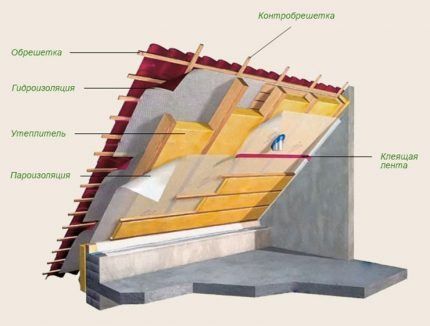
Previously, the holes were reduced with sealants, about 2/3 of the height. I had to move from place to place and wait for the next layer to polymerize. Now the gaps from the waves of the material are covered with relief seals for corrugated board. They are made of foam.
Do not worry about ventilation - thanks to the structure of the seals, even the closed part will allow some air to pass through. In addition to uniforms, a universal tape is suitable for sealing. You can fix it in the right places.
In houses with an attic, the roof is ventilated based on the safety of the structure, air exchange in the room and its temperature regime. At the attic level, air itself moves actively, while cold displaces warm above.
Ventilation is also designed to protect against moisture. Condensate will not get into the lower part of the roof if there are waterproofing and vapor barrier membranes on its way. Many ventilation slots are added to the structure so that the liquids evaporate.
Installation of aerators on the roof
Aerators are also called fungi. Use them to enhance air exchange and remove moisture / vapor. Devices are connected to ventilation gaps directly or through the roof. Aerators are continuous and point.
Solid-type appliances improve ventilation throughout the roof structure. They have sponge filters and cover the entire length of the ridge. Devices are often called ridge devices, as is a variety of point devices. Due to the structural features, solid solid aerators with corrugated board do not combine.
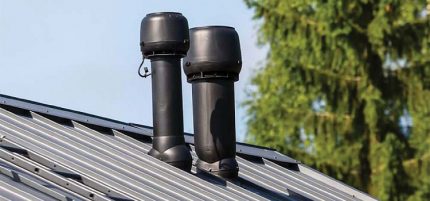
On separate parts of the roofs, point aerators are installed: pitched and ridge.
Point pitched devices set:
- on areas of the roof that are very warm - in as much as possible, if the whole roof is such;
- on slopes of a large area;
- in places of roofs with a complex pattern and bends.
Ideally, pitched aerators are installed in the highest places of the roof, just under the ridge. If there is a valley on the roof, then the devices are fixed no lower than the imaginary lines between the tops of these funnels.
Place at least one point aerator on a 60-100 m² roof. Mount the two units in relative proximity on parts of the roof where more moisture is expected. As a guide, use a wind rose for the terrain. The ramps will receive more rain from the side, from where the wind often blows.
If possible, mount aerators at the same time as the roof. For their installation, choose the line of joints between the insulation: insulation mats partially absorb liquids. With a broken vapor barrier, moisture enters the heater from the house. Secure with dowels or anchors. The ventilated space under the ridge must be protected from leaks, and for this you need a sealing tape or sealant.
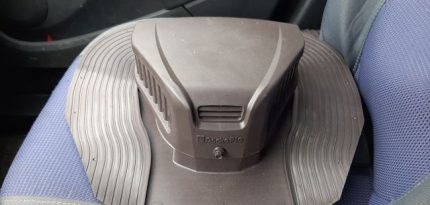
Find the right items for your aerator. Start with the installation site under the wave of profiled sheet. Do not replace it with Master Flash, because it will be difficult to bend it under the terrain. Insert the capsule into the mounting pad and put the adapter on it. Then attach the corrugated pipe, but do not take the aluminum.
If you have to dodge obstacles in the attic, the channel will need to be bent. Aluminum is poorly suited for this. This part will be under the roof. Equip the outside with a deflector.
The ridge point aerators have a flattened shape, and they are mounted on the ridge itself or a little lower. Pitched ones are generally more beneficial, and in some cases irreplaceable. The ridge aerator will not cope with the air exchange in the ramp, elongated in height.
The situation will be the same if the entire roof consists of many bends and transitions. Air stagnates for a long time in these forms. Aerators for structurally complex roofs plan simultaneously with the roof. Then it will be necessary to trace whether the installation site fails.
Ventilation between waterproofing and insulation
Make a ventilation gap between the insulation and waterproofing. So expand the air in the ledge of the slope - at the bottom of the crate, if you look into the thickness of the roofing cake. Make a clearance from the vent to the top edge of the waterproofing.
After the hydroprotection is removed from the insulation, it will also protect well from the liquid from above, and moisture from the thermal insulation will begin to leave faster. The waterproofing film should also absorb moisture, but the air gap is better at handling the task. The air from the gap will go through skate ventilation.
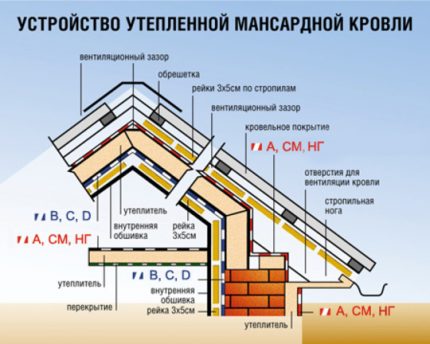
The gap between the insulation and the waterproofing film / membrane is distinguished by stretched fishing lines. Hydroprotection is lifted by at least 5 cm. Fishing lines are attached to the wood using a construction stapler.
A clearance is necessary if the film acts as a hydroprotection. In the case of the membrane, everything is almost the same: most products are not suitable for installation directly on the insulation. You can make a gap, even if it is not mandatory, but remember that ventilation between the corrugated board and the membrane is more important.
Other nuances in the arrangement of ventilation
Air exchange largely depends on the device of the upper and lower edges of the roof. We are talking about the skate at the very top and the air in the edge of the ramp. For a roof from corrugated board, strong natural ventilation in the channel is important, where street air rises, interacts with the internal and goes outside.
Organize ventilation below:
- Take the mesh ventilation tape and cover the lid. Secure with screws. If you wish, make holes in the soffits for a more active air flow. Grid - a necessary measure to protect against foreign objects, birds and insects.
- Install the eaves strip and maintain an interval of at least 3 cm in width to the ventilation. Do not lower its lower end more than 10 cm from the extension. The air itself may be hidden.
- For the entire width of the free interval, cut the polypropylene tubes. Fix the cornice strip with large self-tapping screws.
Then post gutter - on special holders and below the level of the cornice strip.
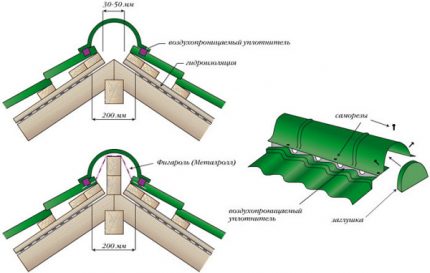
The main element for air outlet is the ridge at the top of the roof. The shape of the ridge can be very different, often has branches, but the main branch is in the upper half meter.
At the interval between the tops of the ramps, a seal or more air-permeable ventilation tape is fixed.
The bars are attached to the tops of the roof sheets, and then the ridge cover is installed on top. The boards are taken 5 cm thick and stacked two in a row, in increments of 40 cm or more. Form triangles up. On both slopes, long wide boards are nailed perpendicular to the bars.
They will become the basis for the skate cover. The latter is done with stiffeners, but relatively flexible in the center. Hardening will not allow the edges of the ridge to move and deform.
On both sides of the ridge between the bars leave air, which is then protected by a ventilation net. To prevent the wood from catching the eye, the cut-out metal straps are screwed to it to match the color of the mesh.
The open ends of the ridge are closed with plugs. Flat is suitable for even skates, and tilted on hips are closed with cones.
Shed roofs with corrugated board are equipped so that the air moves without obstacles and passes through. Overhangs are also equipped with ventilated spotlights.
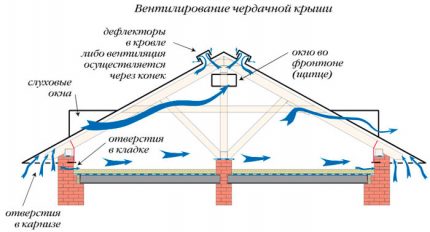
If you are not going to heat the attic, you can install there attic windows for ventilation. Excess moisture in the roof in this case will not appear. On the heated attic, you can maintain a small draft from the ajar windows.
Conclusions and useful video on the topic
Roof ventilation nuances and experimental assembly of a roofing cake:
Seal for protection against snow and cold:
The condition of the cold attic six years after installing the corrugated board, and is it possible to put waterproofing without counter grilles:
You learned what the air exchange system under the roof from a profiled sheet is. Now consider the climate in your area, the estimated load on the roof and the type of planned roof. Add aerators to enhance moisture removal. Make the air gap as wide as possible.
Take care of the passage of aerators and general ventilation through the roof, and count on the flooring only after that. Do not forget about air exchange in the ridge. Control the construction of your roof so that everything works out perfectly the first time.
Write comments, ask questions about roof ventilation from a profiled sheet. Share your experience with other readers if you had to do ventilation on the roof of your house. The contact form is located under the article.

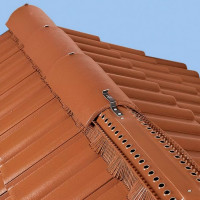 Ventilation of the roof ridge: types + installation manual for ridge strips and aerators
Ventilation of the roof ridge: types + installation manual for ridge strips and aerators  Ventilation pipes for the roof: tips for choosing a pipeline + installation instruction
Ventilation pipes for the roof: tips for choosing a pipeline + installation instruction 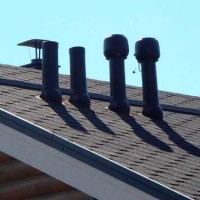 Adjoining the roof to the ventilation shaft: arrangement of the passage of the ventilation unit through the roof
Adjoining the roof to the ventilation shaft: arrangement of the passage of the ventilation unit through the roof 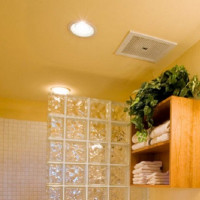 Ventilation in the bathroom in the ceiling: arrangement features + installation instructions for the fan
Ventilation in the bathroom in the ceiling: arrangement features + installation instructions for the fan 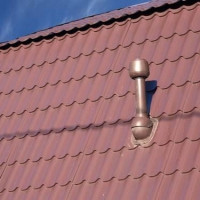 Roof ventilation for metal: an overview of options and nuances of arrangement
Roof ventilation for metal: an overview of options and nuances of arrangement 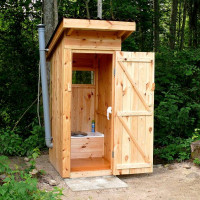 Ventilation in a country toilet with a cesspool: step-by-step instructions and recommendations for arrangement
Ventilation in a country toilet with a cesspool: step-by-step instructions and recommendations for arrangement  How much does it cost to connect gas to a private house: the price of organizing gas supply
How much does it cost to connect gas to a private house: the price of organizing gas supply  The best washing machines with dryer: model rating and customer tips
The best washing machines with dryer: model rating and customer tips  What is the color temperature of light and the nuances of choosing the temperature of the lamps to suit your needs
What is the color temperature of light and the nuances of choosing the temperature of the lamps to suit your needs  Replacement of a geyser in an apartment: replacement paperwork + basic norms and requirements
Replacement of a geyser in an apartment: replacement paperwork + basic norms and requirements